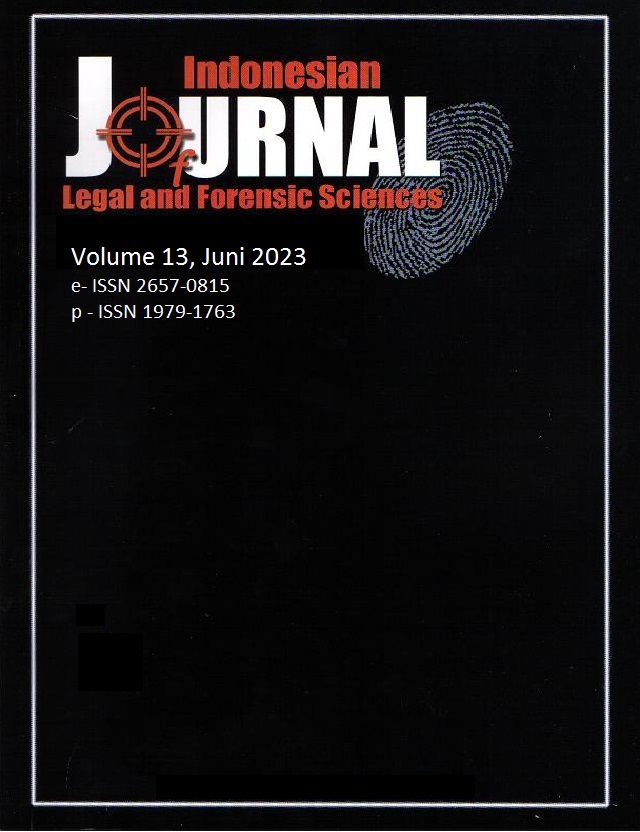Metilparaben, Toksikologi dan Metode Analisisnya dalam Kosmetik
Abstract
Metilparaben merupakan pengawet yang paling umum digunakan dalam kosmetik. Penggunaan metilparaben secara berlebihan memiliki dampak buruk bagi kesehatan. Review ini bertujuan untuk memberi gambaran mengenai aspek toksikologi metilparaben serta metode analisis metilparaben dalam kosmetik yang akurat, tepat, sensitif, dan selektif. Penulisan review ini dilakukan dengan metode kajian literatur (literature review) pada portal seperti Google Scholar, Research Gate, dan Pubmed. Berbagai metode analisis yang telah dipublikasikan dalam analisis metilparaben pada produk kosmetik meliputi HPLC, UPLC, Spektrofotometri UV-Vis, KLT, dan Voltametri. Analisis dengan HPLC menjadi metode yang paling disukai untuk analisis metilparaben dalam kosmetik. HPLC mampu menganalisis metilparaben dalam sampel kosmetik dengan sensitivitas dan selektivitas yang tinggi.
Downloads
References
[2] BPOM RI. 2019. Peraturan BPOM No. 23 Tahun 2019 tentang Persyaratan Teknis Bahan Kosmetika.
[3] Ambarak, MF. Determination of Methylparaben in Some Cosmetics and Pharmaceutics Using Liquid-liquid Extraction and Spectrophotometric Technique. Asian Journal of Green Chemistry. 2019; 4(2): 192-201.
[4] Cabaleiro N, De la Calle I, Bendicho C, Lavilla I. An Overview of Sample Preparation for the Determination of Parabens in Cosmetics. TrAC - Trends in Analytical Chemistry. 2014; 57: 34-46.
[5] Pažoureková S, Hojerová J, Klimová Z, Lucová, M. Dermal Absorption and Hydrolysis of Methylparaben in Different Vehicles Through Intact and Damaged Skin: Using A Pig-Ear Model In Vitro. Food and Chemical Toxicology. 2013; 59: 754-765.
[6] JN O, Udebuani AC, Ezeji EU, Obasi KO, Nnoli MC. Possible Health Implications Associated with Cosmetics: A. Science. 2015; 3(5-1): 58-63.
[7] Soni MG, Burdock GA, Taylor SL, Greenberg NA. Evaluation of The Health Aspects of Methyl Paraben: A Review of The Published Literature. Food Chemical Toxicology. 2002; 40:1335-1373.
[8] Fisher AA. 1996. Esoteric Contact Dermatitis. Part I: The Paraben Paradox. Cutis. 1996; 57: 65-66.
[9] Nielsen NH, Menne T. Allergic Contact Sensitization in An Unselected Danish Population: The Glostrup Allergy Study, Denmark. Archives of Dermato-Venereol. 1992; 72: 456-460.
[10] Fransway AF, Fransway PJ, Belsito DV, Yiannias JA. Paraben Toxicology. Dermatitis. 2019; 30(1): 32-45.
[11] Ishiwatari S, Suzuki T, Hitomi T, Yoshino T, Matsukuma S, Tsuji, T. Effects of Methyl Paraben on Skin Keratinocytes. Journal of Applied Toxicology: An International Journal. 2007; 27(1): 1-9.
[12] Cha HJ, Bae S, Kim K, Kwon SB, An IS, Ahn KJ, An S. Overdosage of Methylparaben Induces Cellular Senescence In Vitro and In Vivo. The Journal of Investigative Dermatology. 2015; 135(2): 609-612.
[13] Dil EA, Ghaedi M, Asfaram A, Tayebi L. Simultaneous Selective Enrichment of Methylparaben, Propylparaben, and Butylparaben from Cosmetics Samples Based on Syringe-To-Syringe Magnetic Fluid Phase Microextraction. Talanta. 2021; 221: 121547.
[14] Dhurhania CE. Penetapan Kadar Metilparaben dan Propilparaben dalam Hand and Body Lotion secara High Performance Liquid Chromatography. Jurnal Farmasi (Journal of Pharmacy. 2012; 1(1): 38-47.
[15] Nikmah MR, Rahmasari KS, Wirasti W, Slamet S. Penetapan Kadar Metilparaben dalam Sediaan Krim Wajah yang Beredar di Kabupaten Pekalongan dengan Metode High Performance Liquid Chromatography (HPLC). Prosiding Seminar Nasional Kesehatan. 2021; 1: 1079-1087.
[16] Abad-Gil L, Lucas-Sánchez S, Gismera MJ, Sevilla MT, Procopio JR. Determination of Paraben-, Isothiazolinone- and Alcohol-Type Preservatives in Personal Care Products by HPLC with Dual (Diode-Array and Fluorescence) Detection. Microchemical Journal. 2021; 160: 105613.
[17] Gao W, Gray N, Heaton J, Smith NW, Jia Y, Legido-Quigley C. UV Gradient Combined with Principal Component Analysis: Highly Sensitive and Specific High Performance Liquid Chromatography Analysis of Cosmetic Creams. Journal of Chromatography A. 2012: 1228; 324-328.
[18] Gao W, Legido-Quigley C. Fast And Sensitive High Performance Liquid Chromatography Analysis of Cosmetic Creams for Hydroquinone, Phenol and Six Preservatives. Journal of Chromatography A. 2011; 1218(28): 4307-4311.
[19] Zgoła-Grześkowiak A, Werner J, Jeszka-Skowron M, Czarczyńska-Goślińska B. Determination of Parabens in Cosmetic Products Using High Performance Liquid Chromatography with Fluorescence Detection. Analytical Methods. 2016; 8(19); 3903-3909.
[20] Martins I, Carreira FC, Canaes LS, Junior FADSC, da Silva Cruz LM, Rath S. Determination of Parabens in Shampoo Using High Performance Liquid Chromatography with Amperometric Detection on A Boron-Doped Diamond Electrode. Talanta. 2011; 85(1); 1-7.
[21] Mincea MM, Lupşa IR., Cinghiţă DF, Radovan CV, Talpos, I. Determination of Methylparaben from Cosmetic Products by Ultra Performance Liquid Chromatography. Journal of the Serbian Chemical Society. 2009; 74(6): 669-676.
[22] Dhahir SA, Hussein HJ. Spectrophotometric Determination of Methyl Paraben in Pure and Pharmaceutical Oral Solution. Advances in Natural Science. 2013; 6(4): 69-74.
[23] Bhandari T, Patel A, Dhodi K, Desai Z, Desai S. Determination of Methyl Paraben from Cosmetics by UV Spectroscopy. International Journal of Pharmaceutical Sciences Review and Research. 2019; 59(1): 17-21
[24] Tjiang WM, Dewi NPDK, Prayoga PAA, Suariyani DPA, Maharani GAK, Rismayani PA, Astuti NMW. Analisis Kualitatif Dan Kuantitatif Kandungan Paraben Dalam Kosmetik Hand Body Lotion. Indonesian Journal of Legal and Forensic Sciences. 2019; 9(2): 89-96
[25] Naik KM, Nandibewoor ST. Electroanalytical Method for The Determination of Methylparaben. Sensors and Actuators A: Physical. 2014; 212: 127-132.
[26] Cahyotomo A, Panglipur HS, Tirta AP, Hayat M, Madiabu MJ. Deteksi Metil Paraben secara Voltametri Menggunakan Elektrode Pasta Karbon. WARTA AKAB. 2022; 46(1): 16-20.
[27] Rao BV, Sowjanya GN, Ajitha A, Uma MVR. A Review on Stability Indicating HPLC Method Development. World Journal of Pharmacy and Pharmaceutical Sciences. 2015; 4(8): 405-423.
[28] Ahuja S, Dong MW. 2005. Handbook of Pharmaceutical Analysis by HPLC. Sixthed. Amsterdam: Elsevier Academic Press.
[29] Bhardwaj SK, Dwivedia K, Agarwala DD. A Review: HPLC Method Development and Validation. International Journal of Analytical and Bioanalytical Chemistry. 2015; 5(4): 76-81.
[30] Gulle, S., H.I. Ulusoy, A. Kabir, A. Tartaglia, K.G. Furton, M. Locatelli, V.F. Samanidou. Application of A Fabric Phase Sorptive Extraction-High Performance Liquid Chromatography-Photodiode Array Detection Method for The Trace Determination of Methyl Paraben, Propyl Paraben and Butyl Paraben in Cosmetic and Environmental Samples. Anal. Methods. 2019; 11(48): 6136–6145.



















